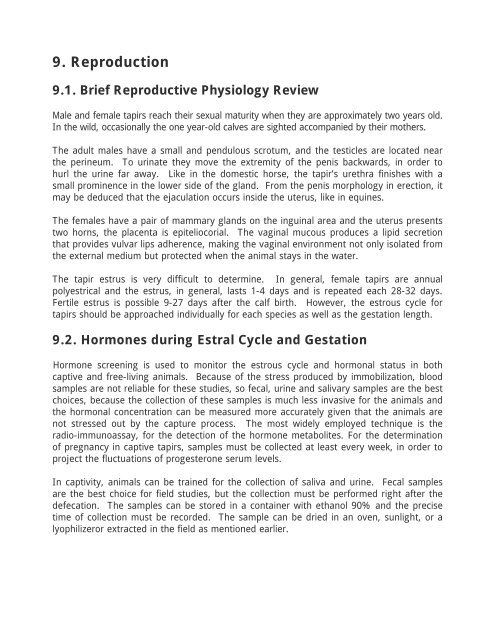TAPIR FIELD VETERINARY MANUAL - Tapir Specialist Group
TAPIR FIELD VETERINARY MANUAL - Tapir Specialist Group
TAPIR FIELD VETERINARY MANUAL - Tapir Specialist Group
Create successful ePaper yourself
Turn your PDF publications into a flip-book with our unique Google optimized e-Paper software.
9. Reproduction<br />
9.1. Brief Reproductive Physiology Review<br />
Male and female tapirs reach their sexual maturity when they are approximately two years old.<br />
In the wild, occasionally the one year-old calves are sighted accompanied by their mothers.<br />
The adult males have a small and pendulous scrotum, and the testicles are located near<br />
the perineum. To urinate they move the extremity of the penis backwards, in order to<br />
hurl the urine far away. Like in the domestic horse, the tapir’s urethra finishes with a<br />
small prominence in the lower side of the gland. From the penis morphology in erection, it<br />
may be deduced that the ejaculation occurs inside the uterus, like in equines.<br />
The females have a pair of mammary glands on the inguinal area and the uterus presents<br />
two horns, the placenta is epiteliocorial. The vaginal mucous produces a lipid secretion<br />
that provides vulvar lips adherence, making the vaginal environment not only isolated from<br />
the external medium but protected when the animal stays in the water.<br />
The tapir estrus is very difficult to determine. In general, female tapirs are annual<br />
polyestrical and the estrus, in general, lasts 1-4 days and is repeated each 28-32 days.<br />
Fertile estrus is possible 9-27 days after the calf birth. However, the estrous cycle for<br />
tapirs should be approached individually for each species as well as the gestation length.<br />
9.2. Hormones during Estral Cycle and Gestation<br />
Hormone screening is used to monitor the estrous cycle and hormonal status in both<br />
captive and free-living animals. Because of the stress produced by immobilization, blood<br />
samples are not reliable for these studies, so fecal, urine and salivary samples are the best<br />
choices, because the collection of these samples is much less invasive for the animals and<br />
the hormonal concentration can be measured more accurately given that the animals are<br />
not stressed out by the capture process. The most widely employed technique is the<br />
radio-immunoassay, for the detection of the hormone metabolites. For the determination<br />
of pregnancy in captive tapirs, samples must be collected at least every week, in order to<br />
project the fluctuations of progesterone serum levels.<br />
In captivity, animals can be trained for the collection of saliva and urine. Fecal samples<br />
are the best choice for field studies, but the collection must be performed right after the<br />
defecation. The samples can be stored in a container with ethanol 90% and the precise<br />
time of collection must be recorded. The sample can be dried in an oven, sunlight, or a<br />
lyophilizeror extracted in the field as mentioned earlier.










